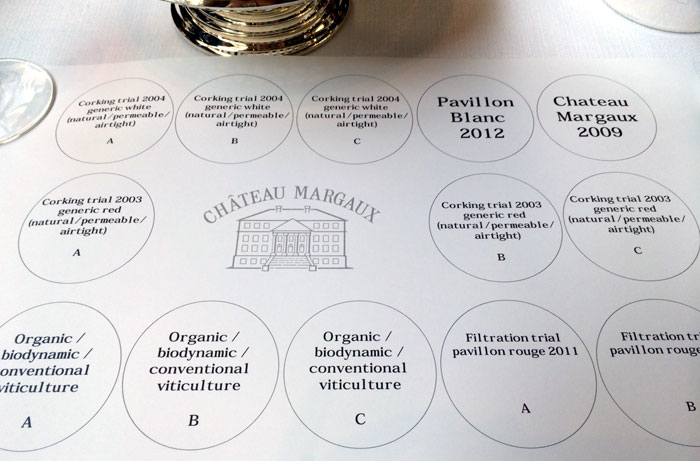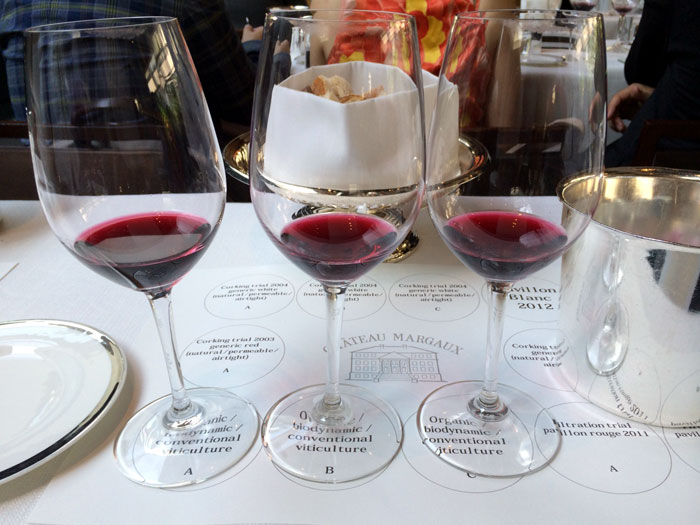With its reputation as the wine hub of Asia, Hong Kong's wine calendar is filled with a vast array of dinners and tastings. However, when this invitation appeared in my in box something about it sounded as though this tasting would be very different. The invitation was as follows:
We would like to invite you to a unique Château Margaux Wine Tasting Event on the 12th of June, at the Grand Hyatt - Pool House in Hong Kong, at 2.30pm.
Château Margaux will reveal the results of some of the research undertaken in its vineyards and cellars, and will give you the opportunity to taste many samples drawn from it.
We organized this exclusive event in the UK and in the USA before, and now it is the first time in Asia for us to share such experiments.
The date was firmly marked in the diary and speculation began about what we would taste.
On the 12th guests duly arrived at the Pool House of the Grand Hyatt - fine wine traders, auction houses, journalists and private collectors. We were greeted by the team from Château Margaux: Thibault Pontallier, his father Paul Pontallier, Aurielien Valance (what's his title?) and Fangyuan Zheng (Shanghai Representative) and requested to take our seats. The Grand Hyatt is known as one of the best venues in town for hosting wine events. The room was professionally set up with immaculate rows of tables and seats, each place with a tasting mat. Glasses lined tables around the edge of the room and the impeccably groomed service staff were on standby waiting to spring into action.
We took our seats and the session commenced. I really do not think anyone in that room knew what to expect, and what was to follow was an insight into a world many would never know existed.

The Château Margaux Presentation Panel.
|
Paul Pontallier explained how in recent years techniques in vinification and viticulture had developed dramatically, especially over the last 60 years where the increase in knowledge has been formidable. Never before has the wine making industry had such a wealth of knowledge at its fingertips. Indeed, if you look around the globe today, we are seeing grapes grown in more places than ever before, producing higher quality wines than ever before, and modern technology enabling better quality wines to be produced even when Mother Nature has dealt a serious blow.
M. Pontallier believes that progress is an experimental science and stressed that Château Margaux feels that such progress relies on the importance of the need to compare. It is not widely known that the château actually started its research department some 30 years ago today employing two full-time staff in the department. As you may be aware, Château Margaux is currently undergoing a major renovation constructing a brand new chais which has been designed by Sir Norman Foster (the same designer who designed Chep Lap Kok airport in Hong Kong). The design has had to carefully marry the old history and surroundings of the estate with the new. This chais will not only provide the latest vinification facilities, but also, right bang in the centre, house the new research and experimental facilities. This area will be enclosed in glass walls for all to see, in keeping with Margaux's theme of transparency for the outside world to share in their discoveries.
Whilst exciting and fascinating, M. Pontallier was keen to emphasize that their research was a long term project. With over 400 years of history he wanted to allay fears that changes are not going to happen overnight. Château Margaux has it's own "style", and a style that the château is determined to keep. It is keen though, to embrace and incorporate new technology, knowledge and ideas into its ethos. The research we were about to taste was still very much a work in progress and, even given the information it has today, it could be another 25 years before a decision is taken to make any changes.
The ensuing "workshop" was going to cover three main topics:
1 Viticulture:
There are three main viticultural methods:
We were then presented with 3 wines, all from the 2013 vintage and all from one plot (a plot that produces grapes which have gone into the production of Margaux's second wine, Pavillon Rouge). The wines were vinified in exactly the same way however, each was made using a different viticultural method.

The tasting mat
|
The room fell silent as everyone tasted the 3 wines. One could instantly tell distinct differences between them. All were very young and a little "green" with rather high acid (2013 was not a ripe vintage). Sample "A" had a more forward and red fruit nose, "B", blacker fruits and more complexity on the palate, "C" was more closed on the nose and had a herbaceous character whilst tighter on the palate and with some stalkiness. It was also a little shorter on the finish than "B". We were asked which of these three we preferred. There is no right or wrong about this, it's just about style. My preference was for "B" (as was the room's) which was in fact organic. It turns out my least favourite ("A") was biodynamic, whilst "C" was traditional, which would have resulted in the largest crop.
2 Filtration:
Currently, Château Margaux does not filter it's wines. We were presented with the next pair of wines to taste, both 2011 Pavillon Rouge. Over 20 years ago 70% of the grapes produced from the 82 ha vineyards would find their way into the first wine, the other 30%, into Pavillon Rouge. In the 2011 vintage just 35% went into Margaux, 38% into Pavillon Rouge and the balance went into the third wine (now distributed in certain markets under agency) and fourth wine (not distributed). One of the pair was filtered (using a 1 micron filter), the other was not. Again there were clear distinctions between both wines with "B" having a better nose than "A". "B" seemed more polished and refined, but then "A", for me, was better on the palate, being more complex and having a longer length on the finish. "A" turned out to be non-filtered, "B" filtered.
3 Closure:
Having covered viticulture and part of vinification we then moved onto another much talked about subject, the type of closure used in the bottles. Nowadays it's not just the disappointment of opening a bottle to find it is corked, but also the financial loss (especially when opening a first growth). There are now four main type of closures - the traditional cork, agglomerated (false) cork, screwcaps (stelvin) with semi-permeable caps (something new to me!) and air-tight screwcaps. Of these, the cork is still the favoured method. Top wines can often be stored for 30 or 40 years and history has shown that cork allows the wines to evolve in the bottle. However, what we do not yet know is how they will develop when other forms of closure are used. Margaux feels it is important that they experiment with different closures and started their trials some 10 years ago. M. Pontallier stressed that they will need to have at least another 20-30 years of testing before, or if, any change is to be made to the current use of cork.

The tasting line-up.
|
In 2002 a rumour spread that Pavillon Rouge was going to be released with screwcaps. M Pontallier recalled the story and explained that 50% of the huge number of customers who contacted the Château were in fact in favour of screwcaps.
Naturally cork companies are also very concerned about their new competition and have been doing their own fair share of research and development. One company is apparently working on a new form of technology which would be able to test every cork for tca prior to it being used.
Three further samples were then served. All were from the 2003 vintage and were described as a generic red. This is in fact it is what the third wine is now. Each of these had been bottled using a different closure. "B" and "C" were more closed on the nose "A" seemed the most forward and developed, "B" had more guts and complexity to it, whilst "C" had complexity with the tannins seeming more integrated. The response in the room was split over whether "B" or "C" was the preference. Surprisingly "A", which the majority thought the most forward, was airtight screwcap, "B" the semi airtight capsule, and "C" the cork closure
We repeated this experiment with three white wines, all 2004 Pavillon Blanc. "A" showed most oxidisation (and indeed was the cork closure), but preferences were again split over "B" and "C" which both had fresher aromas and much better acidity and freshness of fruit on the palate.

The first three reds made using different methods of viticulture.
|
To round off our tasting we were treated to a taste of two wines not from the research department of Château Margaux, but from their cellar reserves.
2012 Pavillon Blanc - incredibly pale in colour, lots of green apples and fruits, gooseberries, herbaceous and cream on the nose. On the palate very clean, crisp fresh acidity, lots of limes, citrus fruits.
2009 Ch Margaux - lovely bright colour holding to the rim (slightly pinky). This wine was double decanted 4 hours prior to serving yet still was a little closed on the nose, however, you could sense that there was great complexity lurking there - minerals, lead pencil, lots of spice, classy dark black fruits. On the palate the wine was amazingly approachable - to be honest you can drink this wine now! There is no doubt there is lots of tannin, but also lots of ripe fruit too which masks the level of tannin, all balanced with cleansing acidity. Again, complex on the palate with mint, elegant dark fruits, velvety almost, spice, licorice. Beautiful length on the finish. The prices of the 09 may have taken a hit in the market, but there is no doubt, this is a remarkable vintage and for those with 2009s in their cellar they are going to have something very, very special in years to come.
I do not believe Hong Kong has ever witnessed such a tasting before. Personally I found it incredibly interesting and wanted to share my experience and explain to customers what goes on behind the scenes at Château Margaux.

2009 Château Margaux
|
There may have been some love lost between consumers and Bordeaux and the market will always have the final say with regard to prices. However, such a tasting makes it clear how much pride and passion goes into the production of these Bordeaux wines. 400 years of history have given Château Margaux enormous experience, but they are resolved not to be complacent, and from what we learned on that sunny afternoon, they have invested not only money, but considerable time and effort, in experimenting with different practices, some of which go against the very core of their personal beliefs, in order to challenge themselves. For Château Margaux to share this information with us was enlightening, and I believe, a hugely positive step in engaging buyers of their wines in an aspect that many may never have realised existed.